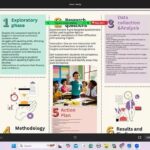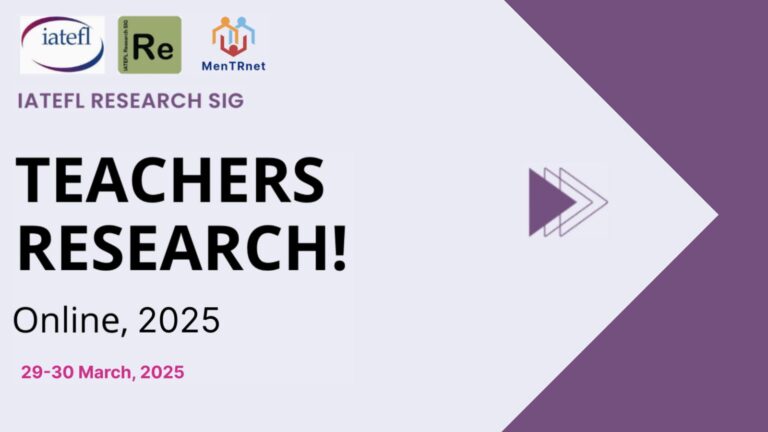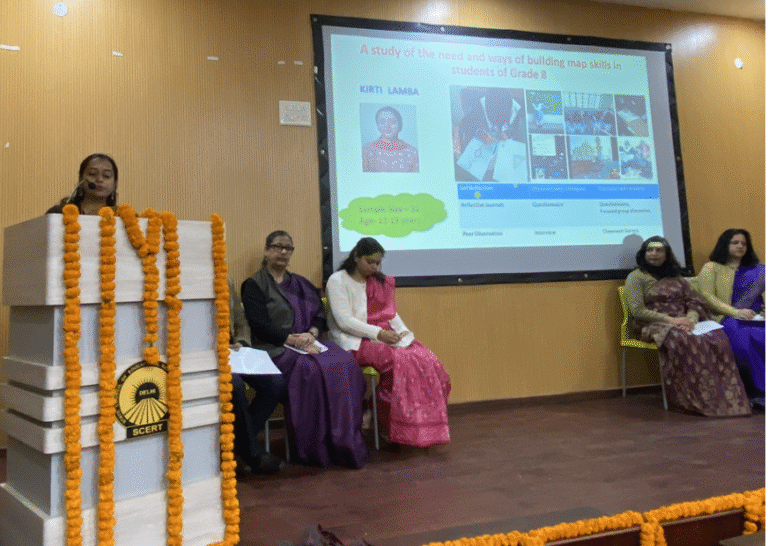
Exploratory Action Research (EAR) is reshaping professional development for English language teaching by providing teachers with tools to reflect on and improve their practices (Burns, 2024; Rebolledo et al., 2016). Interestingly, the spread of EAR has been accompanied by what seems to be a new genre that draws from reflective and self-narrative as well as traditional academic writing genres. The aim of this two-part blog is to provide recommendations for prospective EAR writers, which is in part achieved by an analysis and comparison of current published EAR and non-EAR reports.
Part 1: General characteristics of EAR
EAR is a teacher-driven and context-dependent process (Smith and Rebolledo, 2018). It is not about presenting universally generalizable results but about sharing insights from the EAR process and experience with as much contextual detail as possible so that other teachers can consider transferring the insights to their unique contexts.
A typical EAR project follows this two stage process:
- Exploring: identifying puzzles teachers have about their classroom practice and then working to understand them.
- Acting: designing an action plan based on the previous step, and then monitoring its execution and reflecting critically on the outcome.
This approach foregrounds teacher agency and contextual understanding.
EAR reports vs standard academic writing
EAR establishes a space in which personal voice, emotional engagement and professional rigor can coexist. To understand how EAR reports in a journal might differ from the traditional academic article genre, I decided to compare the two genres. I compared a small set of EAR reports from the ELT Classroom Research Journal (ELTCRJ) with non-EAR reports from the open-access journal Language Learning & Technology in order to identify the main differences in language, structure, references, target audience and focus. I also generated word clouds (Figures 1 and 2) using the R programming package (R Core Team, 2025). The specific articles used for the analysis are listed in the Figure captions further below. Table 1 shows the results of my analysis.
Table 1: Comparison between standard academic writing and EAR report writing.
| Standard Academic Writing | EAR Report Writing |
| Formal tone. Rigid structure of articles (namely, Introduction, Literature Review, Method, Results, Discussion and Conclusions) | Personal voice, semi-formal tone, rich contextual details often presented in a narrative manner |
| Many bibliographical references, which are often not open access. | Personal observations mainly related to the context. Fewer references and often open-access |
| Target audience: researchers, and sometimes practitioners and teacher educators. | Target audience: fellow teachers |
| The focus is on theory and generalizability or transferability through rich description of the context | The focus is on personal and professional growth. Practical relevance to teachers |
| Research starts with a gap in the literature | Research starts in the classroom with an issue or problem that the teacher wants to explore. |
By and large, the language employed in EAR reports is as follows:
- personal growth is reflected in the use of 1st person pronouns (I, we) and possessive adjectives (my, our).
- most of the content words are, apparently, related to students and their learning process. The emphasis is placed on the needs and experiences of both teacher and students (see word cloud in Figure 1) whereas the content words in the academic SLA articles showed a different profile, in which students are not the focus (see Figure 2).

Figure 1: Word cloud of the main content words one can find in six reports published in ELTCRJ: Chopra & Chopra (2025); Htut (2025); Mačėnaitė (2025); Oli & Dahal (2025); Sharma (2025); and Suping & Chopra (2025).

Figure 2: Word cloud of the main content words one can find in five SLA articles published in Language Learning & Technology in 2025: Le & Ziegler (2025), Wach et al. (2025), Poole et al. (2025), Shin & Choi (2025), and Song & Tang (2025).
So what?
EAR reports bridge a gap between academic research and the classroom. They present what Dickey (2024) calls “little r” research: “most teacher-led research starts from a perceived ‘problem’ in the classroom” (Dickey, 2024, p. 8) rather than filling a gap in the literature. They also:
- foreground the dual role of teachers as reflective agents and knowledge creators.
- promote dialogue rather than simple transmission of information.
- give a voice to teachers and empower them to investigate their reality and share their findings in accessible and meaningful ways.
- collaborate in creating a teacher-driven “community of practice”, which opens the door for collaborative professional development.
Part 2: Let’s give it a go
Based on examples published in ELTCRJ (Chopra & Chopra (2025); Htut (2025); Mačėnaitė (2025); Oli & Dahal (2025); Sharma (2025); and Suping & Chopra (2025)), here are ten tips for teachers who would like to write an EAR report for a journal:
- Clearly state the puzzle/challenge that led you to initiate your exploration/inquiry into your own classroom practice and formulate it in the form of a research question or questions – remember, these should be grounded in real classroom experience.
- Describe your context in as much relevant detail as possible.
- Use the first person to share what you did, what you felt and what you learned.
- Share the tools you designed to collect the data for the exploratory stage. Share how you designed them and justify why they were appropriate for your context.
- Weave your data and outcomes into your story rather than describing the data in an isolated section.
- If moving on to the action phase, share your design and implementation of an intervention in the classroom based on the findings in the exploratory phase; evaluate the effects of the outcomes of the intervention and, finally, include a reflection on the intervention, analyzing successes and challenges as well as future actions.
- Present reference literature and peer advice.
- Highlight helpful resources detailing why they were meaningful for your research/inquiry.
- Make your report relatable by having teachers in mind when writing your report since they probably face similar challenges.
- Include an invitation for further dialogue and feedback.
EAR reports give voice by enabling teachers to disseminate their work and thus potentially empower other teachers to do research. A hybrid genre which is part academic, part narrative and part reflective, blending systematic inquiry with storytelling. EAR reports connect with other teacher-researchers and contribute to a shared repository of practical knowledge. They are an invitation for others to join the exploratory journey of research “by teachers and for teachers”.
Now that you have had a brief look inside an EAR report, how about trying to write one? Contact me ([email protected]) and we (in the MenTRnet publications team) will give you a hand . As the song goes, “You’ll never walk alone!”.
Acknowledgements
I would like to thank the MenTRnet Publications Team and Eli Bekes, as well as Susan Dawson and Richard Smith, for their valuable comments and observations that have significantly improved this article. All errors are mine.
References
Chopra, A., & Chopra, S. (2024). Developing writing skills using innovative activities in a Nepali secondary classroom: An EAR project. ELT Classroom Research Journal, 1(1), 93-112. http://doi.org/10.23350/eltcrj.106 [doi.org]
Dickey, R. J. (2024). The call for teachers’ classroom action research. ELT Classroom Research Journal, 1(1), 7–14. http://doi.org/10.23350/eltcrj.102 [doi.org]
Burns, A. (Ed.). (2024). Exploratory action research in Thai schools: English teachers identifying problems, taking action and assessing results. British Council. Retrieved from https://www.britishcouncil.or.th/en/exploratory-action-research-thailand
Htut, W. Y. (2025). The impact of gamification on students’ motivation towards learning system lessons in online classrooms. ELT Classroom Research Journal, 2(1), 9–26. http://doi.org/10.23350/eltcrj.202 [doi.org]
Le, H. T. V., & Ziegler, N. (2025). Technology-mediated TBLT and language development for beginning learners of Vietnamese. Language Learning & Technology, 29(2), 44–75. https://hdl.handle.net/10125/73611
Mačėnaitė, S. (2025). Reflections on the exploration phase of an EAR project on teaching speaking. ELT Classroom Research Journal, 2(1), 27–40. http://doi.org/10.23350/eltcrj.203 [doi.org]
Oli, B., & Dahal, B. (2024). Nepalese students’ reluctance to submit homework in online classes: An EAR perspective. ELT Classroom Research Journal, 1(1), 73-92. http://doi.org/10.23350/eltcrj.105 [doi.org]
Poole, F. J., Coss, M. D., & Clarke-Midura, J. (2025). Developing stealth assessments to assess young Chinese learners’ L2 reading comprehension. Language Learning & Technology, 29(2), 104–131. https://hdl.handle.net/10125/73613
R Core Team. (2025). R: A language and environment for statistical computing. R Foundation for Statistical Computing, Vienna, Austria. https://www.R-project.org/
Rebolledo, P., Smith, R., & Bullock, D. (Eds.). (2016). Champion teachers: Stories of exploratory action research. British Council. Retrieved from https://www.teachingenglish.org.uk/publications/champion-teachers-stories-exploratory-action-research
Sharma, L. (2025). Exploring reluctance towards oral presentations: An EAR study of Nepali secondary students. ELT Classroom Research Journal, 2(1), 59–86. http://doi.org/10.23350/eltcrj.205 [doi.org]
Shin, J., & Choi, Y. (2025).
Using an AI-powered chatbot for improving L2 Korean grammar: A comparison between proficiency levels and task types. Language Learning & Technology, 29(2), 132–160. https://hdl.handle.net/10125/73614
Smith, R., & Rebolledo, P. (2018). A handbook for Exploratory Action Research. British Council. Retrieved from https://www.teachingenglish.org.uk/publications/resource-books/handbookexploratory-action-research
Song, D., & Tang, A. F. (2025). Exploring AI-assistance in L2 Chinese writing with standardized assessment tasks. Language Learning & Technology, 29(2), 161–189. https://hdl.handle.net/10125/73613
Suping, S., & Chopra, A. (2024). Improving Thai teenage students’ confidence to speak English through exploratory action research. ELT Classroom Research Journal, 1(1), 47-72. http://doi.org/10.23350/eltcrj.104 [doi.org]
Wach, A., De Louw, R., Buczak, M., & Loosen, G. (2025).
Strategies for effective communication in Dutch as a lingua franca telecollaboration. Language Learning & Technology, 29(2), 76–103. https://hdl.handle.net/10125/73612
About the Author(s)

Sidney Martin
Sidney Martin is a teacher of English language at the Official School of Languages in Tarragona (www.eoitarragona.cat) and an online tutor at the Institut Obert de Catalunya (ioc.xtec.cat/educacio/eoi). He is interested in how students and teachers deal with feedback delivery and reception in both face-to-face and online environments, more specifically in language learning. He is also interested in pronunciation in second language learning and teaching.




What a delightfully concise and sensible article, hugely useful for our community and beyond. A lot more interesting and educational than any “guide” on the subject. I hope our prospective authors will make good use of it. Thank you, Sidney!